I have created a ASP.NET Core Web with MVC. I scaffolded it with Identity and added my default layout page and used the login page. Now I have ran into the problem that when I log in it doesnt find the column "username" and "password" I belive. Im not quite sure and would appriciate all the help I can get :). This is the error that my website puts out:
MySqlException: Unknown column 'u.AccessFailedCount' in 'field list'
and the red part in the error page is:
var result = await _userManager.CreateAsync(user, Input.Password);
Thanks beforehand!
UPDATE:
Here is some code, I get a lot of "random" values that is not included in my ApplicationUser for some reason.
My ApplicationUser:
public class ApplicationUser : IdentityUser
{
public string Username { get; set; }
public string Password { get; set; }
}
My AuthDbContext:
public class AuthDbContext : IdentityDbContext<ApplicationUser>
{
public AuthDbContext(DbContextOptions<AuthDbContext> options)
: base(options)
{
}
protected override void OnModelCreating(ModelBuilder builder)
{
base.OnModelCreating(builder);
builder.Entity<ApplicationUser>(entity =>
{
entity.ToTable(name: "users");
});
// Customize the ASP.NET Identity model and override the defaults if needed.
// For example, you can rename the ASP.NET Identity table names and more.
// Add your customizations after calling base.OnModelCreating(builder);
}
}
The migrationfile that gets all the random values, I only want to add a table named "users" with Id NOT NULL AUTO_INCREMENT PRIMARY KEY, Username VARCHAR(40) and Password VARCHAR(40). But I get soo many other columns that I dont know where they are comming from.
public partial class InitialCreate : Migration
{
protected override void Up(MigrationBuilder migrationBuilder)
{
migrationBuilder.CreateTable(
name: "AspNetRoles",
columns: table => new
{
Id = table.Column<string>(type: "varchar(767)", nullable: false),
Name = table.Column<string>(type: "varchar(256)", maxLength: 256, nullable: true),
NormalizedName = table.Column<string>(type: "varchar(256)", maxLength: 256, nullable: true),
ConcurrencyStamp = table.Column<string>(type: "text", nullable: true)
},
constraints: table =>
{
table.PrimaryKey("PK_AspNetRoles", x => x.Id);
});
migrationBuilder.CreateTable(
name: "users",
columns: table => new
{
Id = table.Column<string>(type: "varchar(767)", nullable: false),
Username = table.Column<string>(type: "text", nullable: true),
Password = table.Column<string>(type: "text", nullable: true),
UserName = table.Column<string>(type: "varchar(256)", maxLength: 256, nullable: true),
NormalizedUserName = table.Column<string>(type: "varchar(256)", maxLength: 256, nullable: true),
Email = table.Column<string>(type: "varchar(256)", maxLength: 256, nullable: true),
NormalizedEmail = table.Column<string>(type: "varchar(256)", maxLength: 256, nullable: true),
EmailConfirmed = table.Column<bool>(type: "tinyint(1)", nullable: false),
PasswordHash = table.Column<string>(type: "text", nullable: true),
SecurityStamp = table.Column<string>(type: "text", nullable: true),
ConcurrencyStamp = table.Column<string>(type: "text", nullable: true),
PhoneNumber = table.Column<string>(type: "text", nullable: true),
PhoneNumberConfirmed = table.Column<bool>(type: "tinyint(1)", nullable: false),
TwoFactorEnabled = table.Column<bool>(type: "tinyint(1)", nullable: false),
LockoutEnd = table.Column<DateTimeOffset>(type: "timestamp", nullable: true),
LockoutEnabled = table.Column<bool>(type: "tinyint(1)", nullable: false),
AccessFailedCount = table.Column<int>(type: "int", nullable: false)
},
constraints: table =>
{
table.PrimaryKey("PK_users", x => x.Id);
});
migrationBuilder.CreateTable(
name: "AspNetRoleClaims",
columns: table => new
{
Id = table.Column<int>(type: "int", nullable: false)
.Annotation("MySQL:ValueGenerationStrategy", MySQLValueGenerationStrategy.IdentityColumn),
RoleId = table.Column<string>(type: "varchar(767)", nullable: false),
ClaimType = table.Column<string>(type: "text", nullable: true),
ClaimValue = table.Column<string>(type: "text", nullable: true)
},
constraints: table =>
{
table.PrimaryKey("PK_AspNetRoleClaims", x => x.Id);
table.ForeignKey(
name: "FK_AspNetRoleClaims_AspNetRoles_RoleId",
column: x => x.RoleId,
principalTable: "AspNetRoles",
principalColumn: "Id",
onDelete: ReferentialAction.Cascade);
});
migrationBuilder.CreateTable(
name: "AspNetUserClaims",
columns: table => new
{
Id = table.Column<int>(type: "int", nullable: false)
.Annotation("MySQL:ValueGenerationStrategy", MySQLValueGenerationStrategy.IdentityColumn),
UserId = table.Column<string>(type: "varchar(767)", nullable: false),
ClaimType = table.Column<string>(type: "text", nullable: true),
ClaimValue = table.Column<string>(type: "text", nullable: true)
},
constraints: table =>
{
table.PrimaryKey("PK_AspNetUserClaims", x => x.Id);
table.ForeignKey(
name: "FK_AspNetUserClaims_users_UserId",
column: x => x.UserId,
principalTable: "users",
principalColumn: "Id",
onDelete: ReferentialAction.Cascade);
});
migrationBuilder.CreateTable(
name: "AspNetUserLogins",
columns: table => new
{
LoginProvider = table.Column<string>(type: "varchar(128)", maxLength: 128, nullable: false),
ProviderKey = table.Column<string>(type: "varchar(128)", maxLength: 128, nullable: false),
ProviderDisplayName = table.Column<string>(type: "text", nullable: true),
UserId = table.Column<string>(type: "varchar(767)", nullable: false)
},
constraints: table =>
{
table.PrimaryKey("PK_AspNetUserLogins", x => new { x.LoginProvider, x.ProviderKey });
table.ForeignKey(
name: "FK_AspNetUserLogins_users_UserId",
column: x => x.UserId,
principalTable: "users",
principalColumn: "Id",
onDelete: ReferentialAction.Cascade);
});
migrationBuilder.CreateTable(
name: "AspNetUserRoles",
columns: table => new
{
UserId = table.Column<string>(type: "varchar(767)", nullable: false),
RoleId = table.Column<string>(type: "varchar(767)", nullable: false)
},
constraints: table =>
{
table.PrimaryKey("PK_AspNetUserRoles", x => new { x.UserId, x.RoleId });
table.ForeignKey(
name: "FK_AspNetUserRoles_AspNetRoles_RoleId",
column: x => x.RoleId,
principalTable: "AspNetRoles",
principalColumn: "Id",
onDelete: ReferentialAction.Cascade);
table.ForeignKey(
name: "FK_AspNetUserRoles_users_UserId",
column: x => x.UserId,
principalTable: "users",
principalColumn: "Id",
onDelete: ReferentialAction.Cascade);
});
migrationBuilder.CreateTable(
name: "AspNetUserTokens",
columns: table => new
{
UserId = table.Column<string>(type: "varchar(767)", nullable: false),
LoginProvider = table.Column<string>(type: "varchar(128)", maxLength: 128, nullable: false),
Name = table.Column<string>(type: "varchar(128)", maxLength: 128, nullable: false),
Value = table.Column<string>(type: "text", nullable: true)
},
constraints: table =>
{
table.PrimaryKey("PK_AspNetUserTokens", x => new { x.UserId, x.LoginProvider, x.Name });
table.ForeignKey(
name: "FK_AspNetUserTokens_users_UserId",
column: x => x.UserId,
principalTable: "users",
principalColumn: "Id",
onDelete: ReferentialAction.Cascade);
});
migrationBuilder.CreateIndex(
name: "IX_AspNetRoleClaims_RoleId",
table: "AspNetRoleClaims",
column: "RoleId");
migrationBuilder.CreateIndex(
name: "RoleNameIndex",
table: "AspNetRoles",
column: "NormalizedName",
unique: true);
migrationBuilder.CreateIndex(
name: "IX_AspNetUserClaims_UserId",
table: "AspNetUserClaims",
column: "UserId");
migrationBuilder.CreateIndex(
name: "IX_AspNetUserLogins_UserId",
table: "AspNetUserLogins",
column: "UserId");
migrationBuilder.CreateIndex(
name: "IX_AspNetUserRoles_RoleId",
table: "AspNetUserRoles",
column: "RoleId");
migrationBuilder.CreateIndex(
name: "EmailIndex",
table: "users",
column: "NormalizedEmail");
migrationBuilder.CreateIndex(
name: "UserNameIndex",
table: "users",
column: "NormalizedUserName",
unique: true);
}
protected override void Down(MigrationBuilder migrationBuilder)
{
migrationBuilder.DropTable(
name: "AspNetRoleClaims");
migrationBuilder.DropTable(
name: "AspNetUserClaims");
migrationBuilder.DropTable(
name: "AspNetUserLogins");
migrationBuilder.DropTable(
name: "AspNetUserRoles");
migrationBuilder.DropTable(
name: "AspNetUserTokens");
migrationBuilder.DropTable(
name: "AspNetRoles");
migrationBuilder.DropTable(
name: "users");
}
}
NOTE: I just migrated and it all seems to kinda work. But I only want my users to be able to login, I want to create all users backend via MySql CLI. But I have all those weard values that I dont know what to put in..
